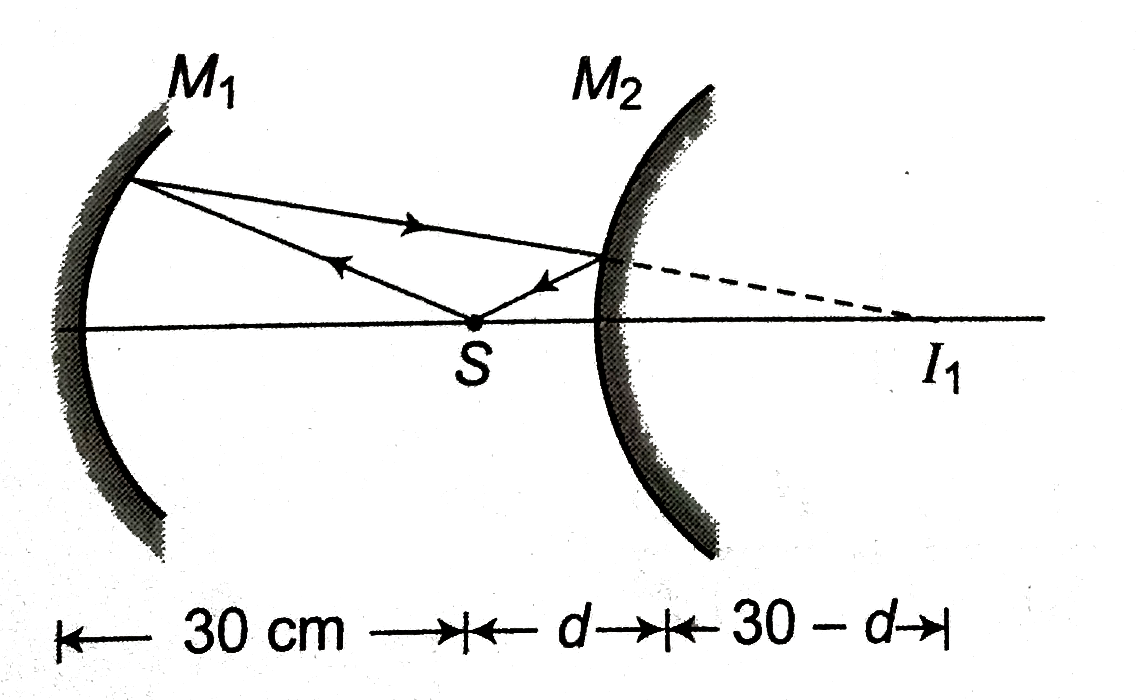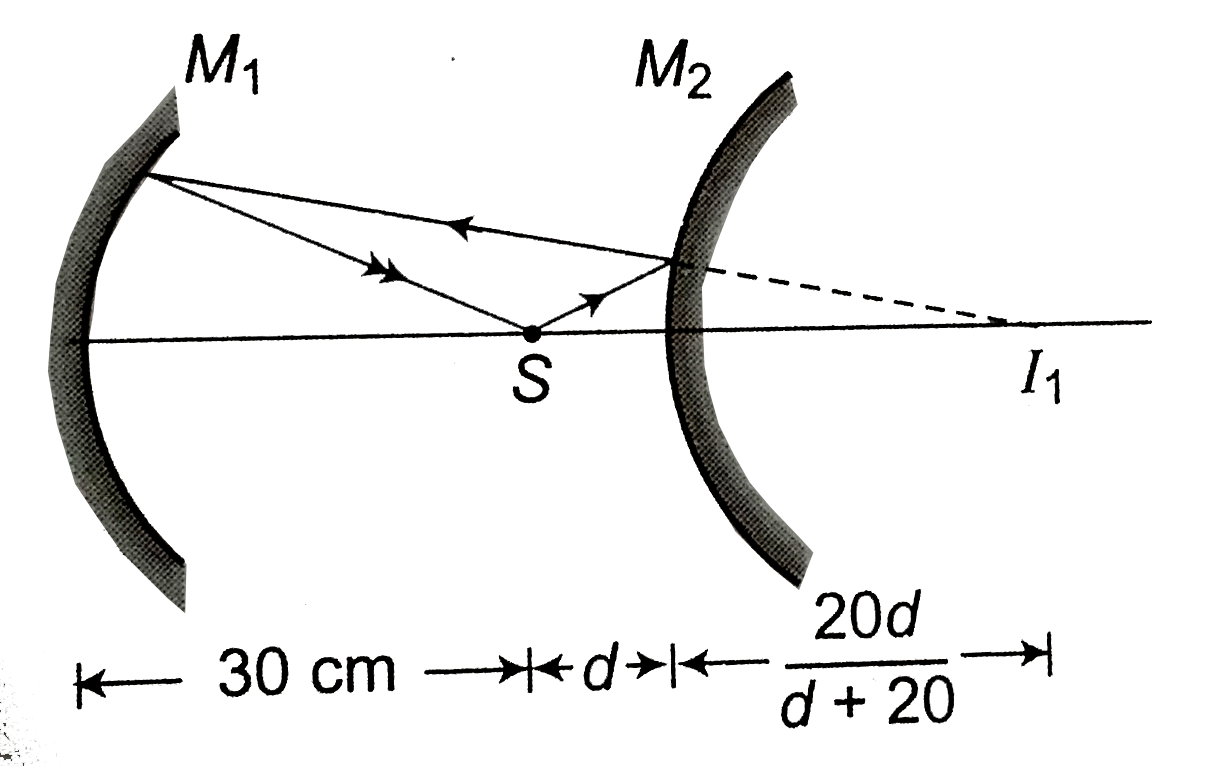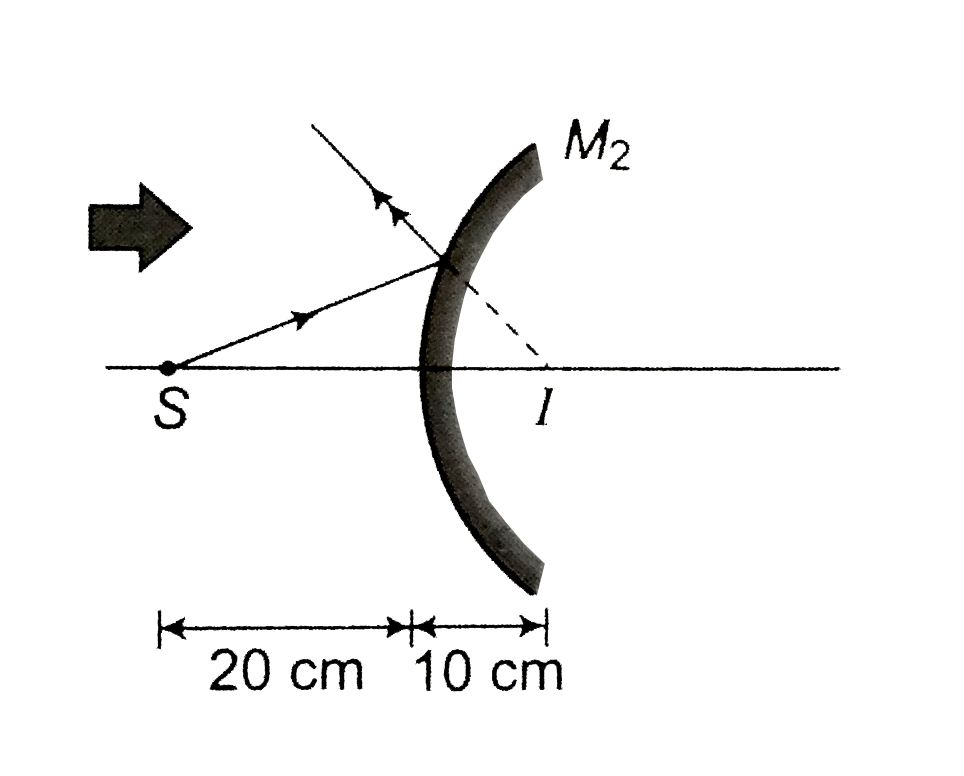A converging mirror M1 a point source S and a diverging mirror M2 are arranged as shown in figure. The source is placed at a distance of 30 cm from M1. The focal length of each of the mirrors is 20 cm. Consider only the images formed by a maximum of two reflections. It is found that one image is formed on the source itself. (a) Find the distance between the two mirrors. (b) Find the location of the image formed by the single reflection from M_2



(a) Image by concave mirror: The direction of incident rays is from right to left
u=−30cm,f=−20cm
1v+1u=1f⇒1v+1−30=1−20
1v=−120+130=−160⇒v=−60cm
Now whether 60 cm is greater than (30+d) or less than (30+d). Since object and image are formed at same place, for this image by convex mirror should be real. The image by convex mirror is real if object is virtual and lie between pole and focus of convex mirror. Hence 60>(30+d). The image of S is formed at I1.
Image by convex mirror: After every reflection, direction of incident ray is reversed, now it is from left to right
u={60−(30+d)}=30−d,v=−d,f=20
1v+1u=1f
1−d+130−d=120
−30+d+dd(30−d)=120
−600+40d=30d−d2
d2+10d−600=0
(d+30)(d−20)=0
d=20cm,d=−30 (not possible)
The separation between two mirrors =30+d=50cm
(b) 1v+1−20=120
v=10cm
Topper's Solved these Questions
- REFLECTION OF LIGHTBook:CP SINGHChapter:REFLECTION OF LIGHTExercise:EXERCISES
Explore 67 Videos
- PHOTOELECTRIC EFFECTBook:CP SINGHChapter:PHOTOELECTRIC EFFECTExercise:EXERCISES
Explore 73 Videos
- REFRACTION AT SPHERICAL SURFACESBook:CP SINGHChapter:REFRACTION AT SPHERICAL SURFACESExercise:EXERCISES
Explore 105 Videos
Similar Questions
An object is placed at a distance of 30 cm in front of a convex mirror of focal length 15 cm. Write four characteristics of the image formed by the mirror.
View SolutionA point source S is placed at a distance of 15 cm from a converging lens of focal length 10 cm on its principal axis. Where should a diverging miror of focal length 12 cm be placed to that a real image is formed on the source itself.
View Solution
Knowledge Check
An object is placed at a distance of 20 cm from the pole of a concave mirror of focal length 10 cm. The distance of the image formed is
A+20cmB+10CmC−20cmD−10cmA point object is placed at a distance of 30 cm from a convex mirror of focal length 30 cm. The image will form at
AInfinityBFocusCPoleD15 cm behind the mirrorAn object is placed at a distance of 30 cm from a concave mirror and its real image is formed at a distance of 30 cm from the mirror. The focal length of the mirror is
A15 cmB45 cmC30 cmD20 cm
An arrow 2.5 cm high is placed at a distance of 25 cm from a diverging mirror of focal length 20 cm. Find the nature, position and size of the image formed.
View SolutionAn arrow 2.5 cm high is placed at a distance of 25 cm from a diverging mirror of focal length 20 cm. Find the nature, position and size of the image formed.
View SolutionA point source S is placed at distance of 15 cm from a converging lens of focal length 10 cm . Where should a (i) concave mirror (ii) convex mirror of focal length 12 cm be placed so that real image is formed on object itself.
View SolutionA convex mirror forms an image one-fourth the size of the object. If object is at a distance of 0.5 m from the mirror the focal length of the mirror is
View SolutionAn object is kept at a distance 20 cm from a convex mirror of focal length 20 cm. The image will form at
View Solution